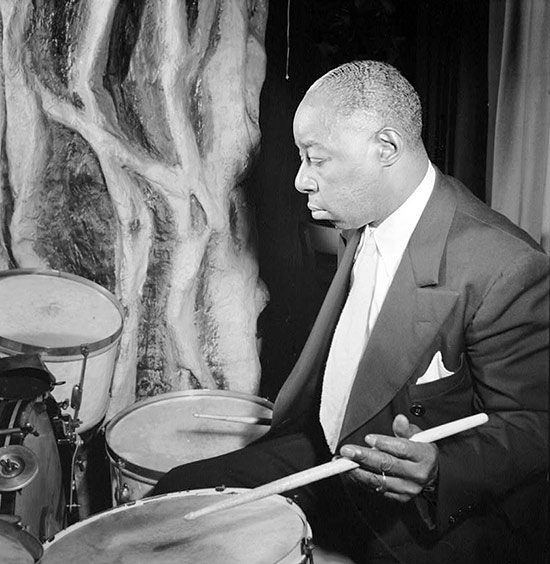Warren ‘Baby’ Dodds, born in 1897. Baby was the younger brother to Johnny Dodds (a clarinettist who was one of the most influential and original reedmen in those early years). Baby was a trained drummer and had a good understanding of military drumming. His heritage was what made Dodds different from a traditional straight parade drummer. Dodds was a descendant of African slaves. His ancestors were slaves, and the rhythms from that exotic continent were passed on to him. Jazz was born from this mix of European music and European tradition. Dodds played in parades from the 1910s with Bunk Johnson and “Frankie Dusen’s Eagle Band”, often together. In the “Fewclothes Cabaret”, he played gigs that were not parade-related. After a brief stint with “Oscar Papa Celestin”‘s Band, the young drummer joined Fate Marable’s band on the SS Sydney. He joined Joe ‘King’ Oliver’s Creole Jazz Band in 1921, and made his first recordings with them in 1923. Louis Armstrong, a 22-year-old cornet wizard, was featured in this all-star lineup. These acoustic recordings only hint at the sound of Oliver’s band. Baby’s ability to play the woodblock and choke cymbal is severely limited by the absence of a complete drum kit. The Dodds rhythm was a major factor in the band’s big sound. Musicians who heard it were impressed. Baby was already playing in brother Johnny’s band by 1927. You can hear him with a full drum set on recordings made “Johnny Dodds his Black Bottom Stompers.” “Come on, Stomp Stomp Stomp!” These October 1927 sessions were the first to include a bass drum. Baby plays it in two-beats. This rhythm section sound was very similar to Oliver’s. The cornet lineup of this band was identical to Oliver’s. Baby is given a drum break during the trombone solo of “After You’ve Gone”. He also found regular employment with the various Washboard bands. Baby’s technique deserves some scrutiny. The bass drum plays two beats behind the bar. The snare drum plays press rolls. The left stick is used to roll across the drum, accented with beats two through four. In most cases, the right stick plays four beats. The roll begins on beat two and continues on beat four. Accents can be made with the tom toms, woodblocks, rims, and cymbals. I know this is a gross oversimplification. Baby Dodds was so much more than that. I recommend a closer look at the CDs below. Baby could play many beats on blocks including triplets, double stroke rolls and parradiddles. The beat was always moving and had a wide range of widths. Dodds’ disciples Gene Krupa and George Wettling were white drummers who were ‘on-the beat’ players. Dodds, however, often played around the time, adding accents to places they weren’t expecting. Baby’s blocks can also be heard on Jelly Roll Morton’s recording of “Billy Goat Stomp”, which also features an early Dodds solo that is played over a series of breaks. Dodds had to learn to use wire brushes with Jelly. He is also the first jazz drummer to record using this lighter alternative to sticks. Baby’s brush style is best illustrated in “Mr.Jelly Lord”, which is an adaptation of his press roll except that the brush is moved across the snare drum instead of being rolled. The other brush plays a steady four beats. A comparison with Gene Krupa’s work with the “Benny Goodman Trio”, in the late 30s, shows that Krupa received more from Dodds than his stick technique. In the Depression years, Bill Dodds was unable to make a living playing music and Baby had to be aided by his brother Bill to run a taxi company. Baby recorded as part of the New Orleans Album for Decca. Victor Records also had the chance to pair him with Sidney Bechet, a great New Orleans soprano jazz saxophonist. This made for some unforgettable sides in 1941. The lineup was complete by Earl Hines (piano, Rex Stewart and cornet), Welman Braud (another New Orleanian) and Welman Braud. Dodds is able to use a variety of strokes, rolls and tempos in his solo. He plays on the cowbell, rims, and blocks. Baby was Bunk Johnson’s chosen drummer when Bill Russell recorded him in 1944. These American Music recordings are where we can hear Baby in his full glory, even though they were made with less than perfect equipment. Baby Dodds is often considered to be old-fashioned and outdated. However, Art Blakey, one the greatest Jazz drummers, played Dodds fills along with his forward-looking hard bop group, The Jazz Messengers. Dodds is still one of the most innovative and colorful drummers in the history and tradition of Jazz. His paralysis in the early 50s from strokes cost him his life. He died in 1959. from http://www.drummerworld.com
